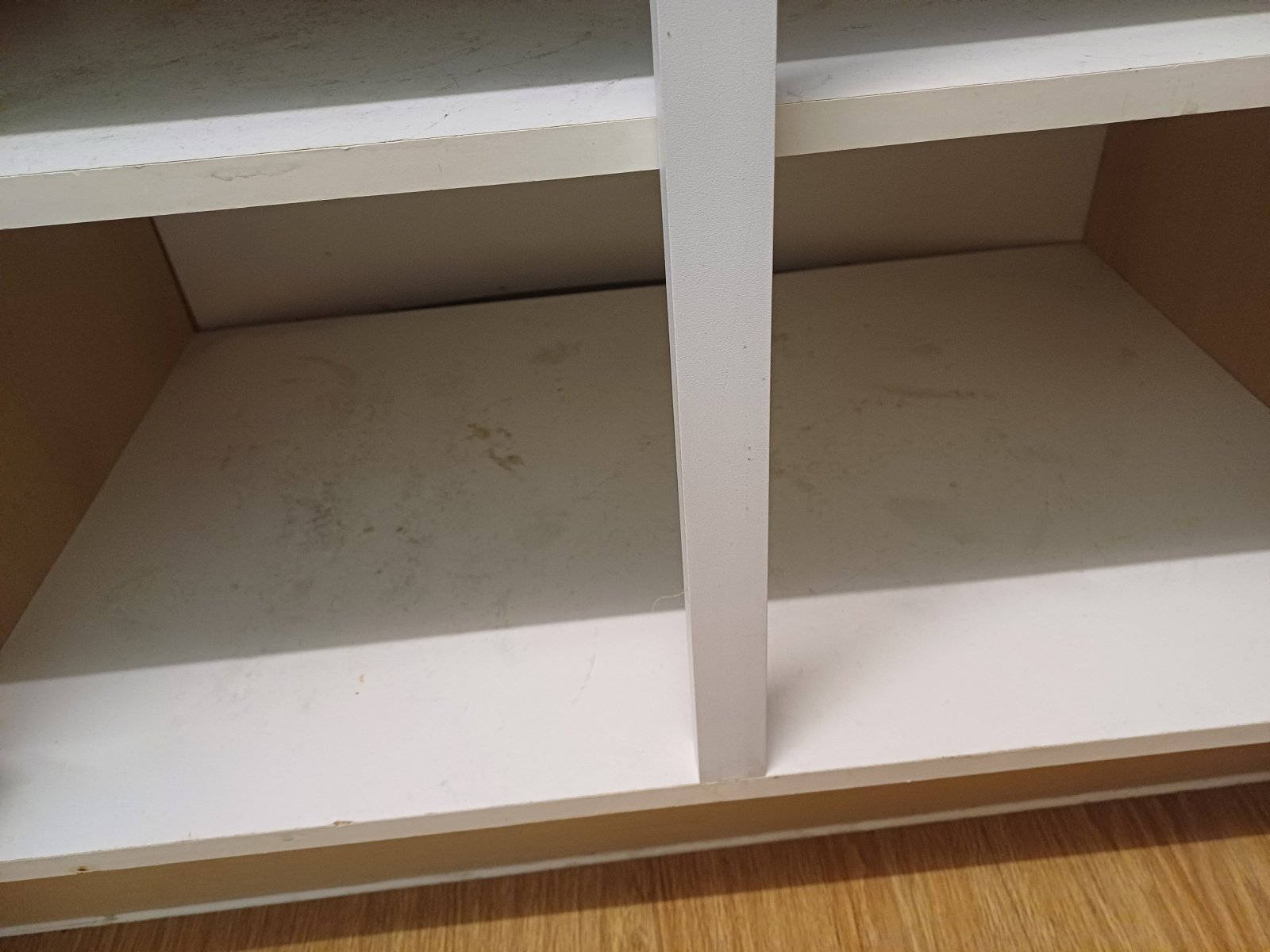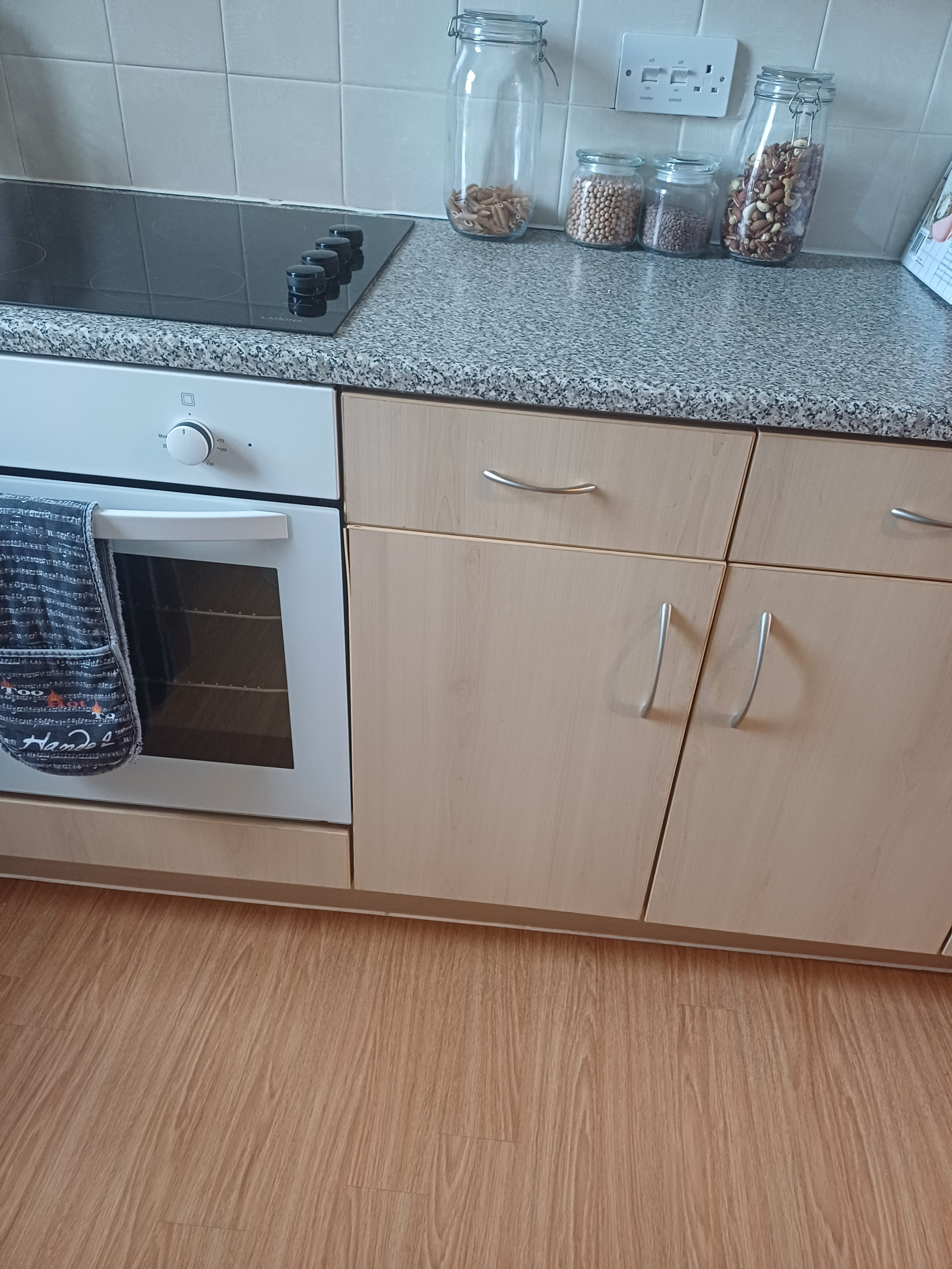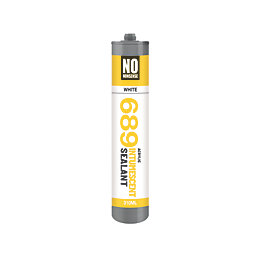We’d like to remind Forumites to please avoid political debate on the Forum.
This is to keep it a safe and useful space for MoneySaving discussions. Threads that are – or become – political in nature may be removed in line with the Forum’s rules. Thank you for your understanding.
📨 Have you signed up to the Forum's new Email Digest yet? Get a selection of trending threads sent straight to your inbox daily, weekly or monthly!
Sealing gaps in wall
mathilde
Posts: 173 Forumite





Happy new year.
I live in a block of flats. It's pretty well insulated, except for the floor-level kitchen cabinets. As shown in the photos, the backs of the cabinets are open. Behind them there is just bricks. On the rare occasions that the adjoining neighbours smoke, the smell comes right in. Also the occasional mouse gets in. However I'm most concerned about the fire risk. There's meant to be insulation to protect my flat from smoke in the event of a fire in an adjacent flat.
I want to do a simple DIY fix because the kitchen is fine otherwise. I don't care too much about aesthetics because they're hidden.
A few questions:
1. Does expanding foam sound like a crazy idea? Seems like it would be effective but I'm concerned about carcinogens.
2. I could hire a carpenter to put in new backing and seal with silicone? (Maybe also add insulation?)
3. Another tack: is it possibly something the freeholder ought to address, since it has to do with fire safety within the building? I'm (I own the flat so I'm responsible for the flat itself, with the freeholder responsible for the building.) I'll inquire with a friend of mine who is a housing sol, just wondering if anyone happens to know.
I'll inquire with a friend of mine who is a housing sol, just wondering if anyone happens to know.
Would be very grateful any insights. Thank you!
I live in a block of flats. It's pretty well insulated, except for the floor-level kitchen cabinets. As shown in the photos, the backs of the cabinets are open. Behind them there is just bricks. On the rare occasions that the adjoining neighbours smoke, the smell comes right in. Also the occasional mouse gets in. However I'm most concerned about the fire risk. There's meant to be insulation to protect my flat from smoke in the event of a fire in an adjacent flat.
I want to do a simple DIY fix because the kitchen is fine otherwise. I don't care too much about aesthetics because they're hidden.
A few questions:
1. Does expanding foam sound like a crazy idea? Seems like it would be effective but I'm concerned about carcinogens.
2. I could hire a carpenter to put in new backing and seal with silicone? (Maybe also add insulation?)
3. Another tack: is it possibly something the freeholder ought to address, since it has to do with fire safety within the building? I'm (I own the flat so I'm responsible for the flat itself, with the freeholder responsible for the building.)
 I'll inquire with a friend of mine who is a housing sol, just wondering if anyone happens to know.
I'll inquire with a friend of mine who is a housing sol, just wondering if anyone happens to know.Would be very grateful any insights. Thank you!
Mortgage in July 2023: £84206
Mortgage in December 2025: £66292
Mortgage in December 2025: £66292
0
Comments
-
You'd have to take the backs off the carcases then use an intumescent sealant or sealing strips - they are fire retardent. The screwfix one pictured is currently £5
Mr Generous - Landlord for more than 10 years. Generous? - Possibly but sarcastic more likely.3 -
Thanks very much for the response and recommendation. Just to clarify, do you mean take the backs off the cabinets and then seal the cracks in the wall behind?Mortgage in July 2023: £84206
Mortgage in December 2025: £662920 -
By 'bricks', do you mean the plastered wall? It's hard to tell from that photo, but it appears to me that there is a unit backboard there?mathilde said:Happy new year.
I live in a block of flats. It's pretty well insulated, except for the floor-level kitchen cabinets. As shown in the photos, the backs of the cabinets are open. Behind them there is just bricks. On the rare occasions that the adjoining neighbours smoke, the smell comes right in. Also the occasional mouse gets in. However I'm most concerned about the fire risk. There's meant to be insulation to protect my flat from smoke in the event of a fire in an adjacent flat.
I want to do a simple DIY fix because the kitchen is fine otherwise. I don't care too much about aesthetics because they're hidden.
A few questions:
1. Does expanding foam sound like a crazy idea? Seems like it would be effective but I'm concerned about carcinogens.
2. I could hire a carpenter to put in new backing and seal with silicone? (Maybe also add insulation?)
3. Another tack: is it possibly something the freeholder ought to address, since it has to do with fire safety within the building? I'm (I own the flat so I'm responsible for the flat itself, with the freeholder responsible for the building.) I'll inquire with a friend of mine who is a housing sol, just wondering if anyone happens to know.
I'll inquire with a friend of mine who is a housing sol, just wondering if anyone happens to know.
Would be very grateful any insights. Thank you!
That's largely moot, tho', since even units with backs are often open along the top, presumably to allow them to ventilate, or possibly just ease of construction.
Your plinths look to be sealed - siliconed - where it meets the floor covering? Annoying, because it would help you if these could be removed so you could hopefully see where the leaks are into your flat, and I imagine it's just a few isolated points such as where the waste pipes and other plumbing comes through. Get to these, and jobbie jobbed.
But getting to them is the problem...
Ideally, you'd pull off these plinths, and find telescopic legs. Unfasten the cabinets and screw up the legs, and the base units should be pulloutable. That would give you ideal.access to the problem.
There are foams that are supposed to be rodent repelling, but no idea how good they are. Personally, I'd go mortar, or other solid filler, pressing and packing it in as far as it possible.
First I'd cut plastic sleeves to slip tightly over these pipes, and push them through first - you don't want mortar in direct contact with these pipes for both potential noise reasons - expansion creaks - and possible corrosion.
Then by all means beads of foam or frame sealant along the wall-floor joint, and any remotely suspect cracks and gaps.
I did mil's kitchen after we discovered meece had been visiting, but could only access under the units via the plinths. Flat on back, full stretch, added nozzles for length, and a complete foamy mess left under there. Used anti-rodent stuff, and no return visits, but getting into the wall corner involved 'firing' the foam, with the stuff tumbling over itself to make gentle contact with the wall. Pity the fool who has to do anything to the plumbing under there...
So, if you can, units out. Seal. Then firmly attach proper back panels securely to your units, and replace - they should slot back in. Not all units need to come out, but any should help.0 -
Our old house had a cupboard in a similar condition. Unfortunately it was a full height one and couldn't be pulled out, and the backboard had basically warped so wouldn't click back into it's groove. It was either do a botch job or replace altogether. The botch job won. I screwed some screws into the back board so I could get some purchase on it, plastered no more nails near the joins, then pulled it tight to the back of the cupboard, rigged it up while the NMN dried, then derigged it. It was fine when we moved out last year so a good couple of years since fixed. If you have issues behind the backboard, I'd have it all out as suggested above.1
-
ThisIsWeird said: But getting to them is the problem...
Ideally, you'd pull off these plinths, and find telescopic legs. Unfasten the cabinets and screw up the legs, and the base units should be pulloutable.But the base units may be fixed to the wall, possibly with brackets installed before the worktop went on. There is often connecting screws between adjacent units. And to top it off, the units will have been pushed together during installation to get a snug fit. Extracting just one unit could well be a lot more than "should be pulloutable". Then of course, you have to get it back in with zero wriggle room..If the plinth can be removed, put a bead of adhesive down the back of the bottom shelf and use some long cramps to close the gap up. Leave for ~24 hours, and then refit the plinth (after removing the cramps).
Any language construct that forces such insanity in this case should be abandoned without regrets. –
Erik Aronesty, 2014
Treasure the moments that you have. Savour them for as long as you can for they will never come back again.1 -
How sure are you that the smoke and mouse are coming in from that area?0
-
FreeBear said:But the base units may be fixed to the wall, possibly with brackets installed before the worktop went on. There is often connecting screws between adjacent units. And to top it off, the units will have been pushed together during installation to get a snug fit. Extracting just one unit could well be a lot more than "should be pulloutable". Then of course, you have to get it back in with zero wriggle room..As I said, "Unfasten the cabinets..." - that's what I'm referring to. But all these fixings should be accessible.A normal base unit, which does not have complicating issues such as sinks and ovens and hobs, can be removed as a single item in most cases, and replaced exactly. And doing this should very much help gain sight and access to where the smells are coming through.I couldn't do this on mil's kitchen as it was small and U-shaped, with a sink to the left, and a cooker and hob in front - there were no base units that could be individually pulled out. And, blimey, reaching in under the units to try and seal gaps was deeply unpleasant.0
-
Thanks a lot for the detailed and thoughtful comments.
Yes the smoke is definitely coming from the gaps in the cabinets. As are the mice.
The cabinets are all integrated in, so unfortunately removing them isn't an option. I'm saving up for a proper kitchen reno. I like the idea of removing the plinth to see if I can get a better sense of the gaps. The plinth is caulked to the floor but that's easily redone.
All of the ideas have been really helpful, thank you.Mortgage in July 2023: £84206
Mortgage in December 2025: £662921 -
Here's a follow-up photo: as you can see it's an integrated kitchen, so the cabinets are attached to the counter which is attached to the cooker and it's all caulked to the tiled wall above. So yes, unfortunately I can't just pull away the cabinets and fix the wall.

Mortgage in July 2023: £84206
Mortgage in December 2025: £662922 -
mathilde said:Here's a follow-up photo: as you can see it's an integrated kitchen, so the cabinets are attached to the counter which is attached to the cooker and it's all caulked to the tiled wall above. So yes, unfortunately I can't just pull away the cabinets and fix the wall.
 Yes, I'd assumed it was a fully-fitted kitchen.If, when you remove the plinths, you find the units have telescopic legs (altho', due to the low plinth height, I fear you might not), then the units you have shown - the oven and the double to its right - should be very removable.Fascias off, all screws into the back wall, up into the worktop, and through to the side units, removed. Telescopic legs screwed up, so the unit can drop down a bit. The unit should then be pullable oot, leaving the rest of the kitchen, worktops, everything, in place. Once the job is done, the unit gets slid back into place - yes it's tight, but obviously it will fit - legs screwed out to raise the unit up, and all the fixing holes should line up again perfectly. Screw.Where is the sink unit in that kitchen? Could you post a pic of the whole kitchen?But, removing just the plinths should hopefully reveal useful info.0
Yes, I'd assumed it was a fully-fitted kitchen.If, when you remove the plinths, you find the units have telescopic legs (altho', due to the low plinth height, I fear you might not), then the units you have shown - the oven and the double to its right - should be very removable.Fascias off, all screws into the back wall, up into the worktop, and through to the side units, removed. Telescopic legs screwed up, so the unit can drop down a bit. The unit should then be pullable oot, leaving the rest of the kitchen, worktops, everything, in place. Once the job is done, the unit gets slid back into place - yes it's tight, but obviously it will fit - legs screwed out to raise the unit up, and all the fixing holes should line up again perfectly. Screw.Where is the sink unit in that kitchen? Could you post a pic of the whole kitchen?But, removing just the plinths should hopefully reveal useful info.0
Confirm your email address to Create Threads and Reply

Categories
- All Categories
- 352.8K Banking & Borrowing
- 253.8K Reduce Debt & Boost Income
- 454.6K Spending & Discounts
- 245.8K Work, Benefits & Business
- 601.9K Mortgages, Homes & Bills
- 177.7K Life & Family
- 259.7K Travel & Transport
- 1.5M Hobbies & Leisure
- 16K Discuss & Feedback
- 37.7K Read-Only Boards




